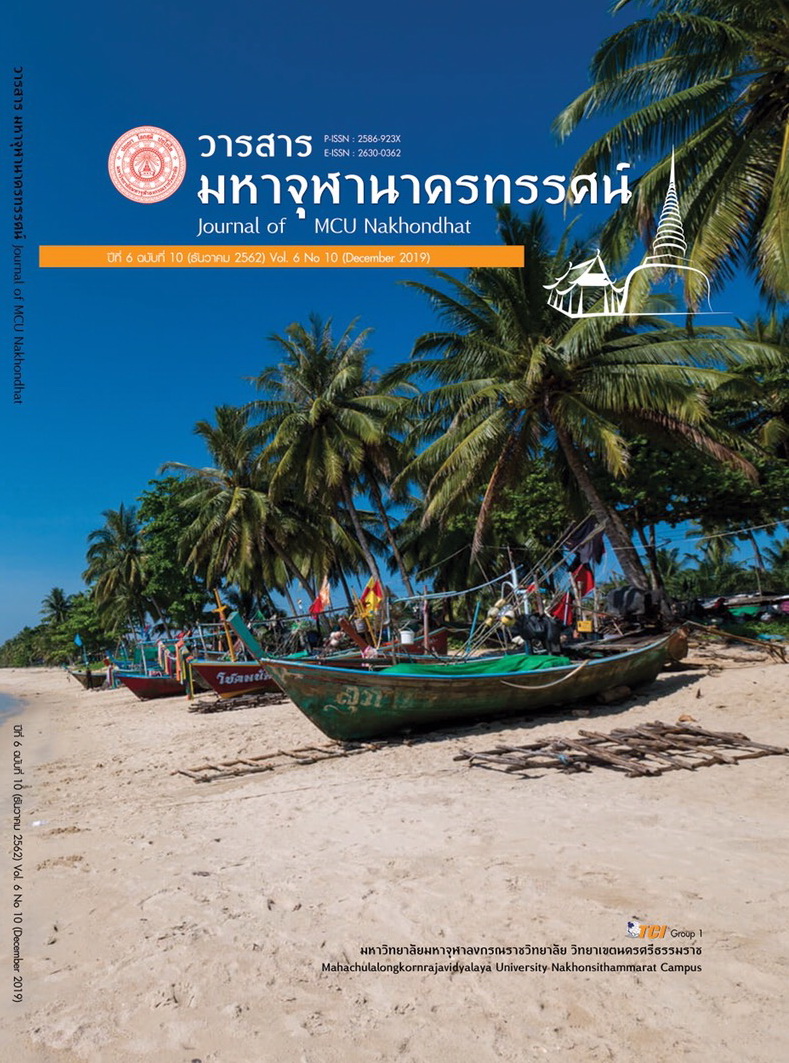A MODEL OF MONASTICS ADMINISTRATION MANAGEMENT BY BUDDHIST PEACEFUL MEANS
Main Article Content
Abstract
The three objectives of this dissertation were 1) to study the principle of Monastics Administration Management. 2) to study the Buddhist peaceful means, 3) to present the Model of Monastics Administration Management by Buddhist Peaceful Means. This dissertation is the qualitative research that by documents, in depth interview and focus group discussions from 53 key informants from five groups.
The findings of this study were as follows:
- The principle of Monastics Administration Management had the principle by model that adapted the kingdom’s rule since Buddha time, Sukhothai kingdom, Ayutthaya Kingdom, Ratanakosin Kingdome up to the present by having the Dhammavinaya as the main constitution to relate the principle of organization management as Sangha, is the moral community of Thai society.
- The Monastics Administration Management since the past up to the present is the power center of Supreme Sangha Council such as power of legislature, executive and judiciary due to the Sangha Act that had the structure as the kingdom or government in each age. That is not proper for the Monastics Administration Management at the present. The temple gets the guideline and improve the role of temple in the twenty sixth century by using the Dhammavinaya, law, tradition and modern innovation to integrate with Buddhist peaceful means.
- The model of Monastics Administration Management for the administration by using the modern science. The researcher called it as the Noble Eightfold Path such as planning, management, recruitment, decision, command, control, network cooperation and communication in the form of committee. The model of Monastics Administration Management in the form of “Committee” by using the Noble Eight fold path is as the proceeding tool by principle of Aparihaniyadhamma to control the committee in Monastics Administration Management in the sake of security and sustainability of Buddhism along with Thai society.
Article Details
How to Cite
ช่วยธานี ฉ., บรรณรุจิ บ., & วัฒนะประดิษฐ์ ข. (2020). A MODEL OF MONASTICS ADMINISTRATION MANAGEMENT BY BUDDHIST PEACEFUL MEANS. Journal of MCU Nakhondhat, 6(10), 5092–5105. retrieved from https://so03.tci-thaijo.org/index.php/JMND/article/view/224246
Section
Research Articles
References
จารุรัตน์ ปั้นมณี. (2550). กฎหมายคณะสงฆ์. กรุงเทพมหานคร: โรงพิมพ์สำนักงานพระพุทธศาสนาแห่งชาติ.
พระครูวิสุทธานันทคุณ (สุรศักดิ์ วิสุทฺธาจาโร). (2558). การบริหารจัดการวัดเพื่อความมั่นคงแห่งพระพุทธศาสนา. ใน วิทยานิพนธ์พุทธศาสตรดุษฎีบัณฑิต สาขาวิชาการจัดการเชิงพุทธ. มหาวิทยาลัยมหาจุฬาลงกรณราชวิทยาลัย.
พระมหาดนัย อุปวฑฺฒโน (ศรีจันทร์). (2557). รูปแบบการบริหารจัดการองค์กรสันติสุข : ศึกษากรณี วัดปัญญานันทาราม อำเภอคลองหลวง จังหวัดปทุมธานี. วารสารสันติศึกษาปริทรรศน์ มจร, 3(1), 24-27.
พระมหาดาวเรือง วรปญฺโญ. (2557). พระพุทธศาสนาในอินเดีย. กรุงเทพมหานคร: โรงพิมพ์เอกพิมพ์ไทย จำกัด.
พระราชวรเมธี, ดร. และคณะ. (2559). แผนยุทธศาสตร์การปฏิรูปกิจการพระพุทธศาสนา 2560 - 2564. กรุงเทพมหานคร: สำนักงานพระพุทธศาสนาแห่งชาติ.
พระวีระศักดิ์ ชยธมฺโม (สุวรรณวงศ์). (2557). แนวทางการจัดการวัดสันติสุขตาม หลักสัปปายะ 7 สำหรับวัดธารน้ำไหล (สวนโมกขพลาราม). วารสารสันติศึกษาปริทรรศน์ มจร, 3(2), 99-112.
สุนทร มณีสวัสดิ์. (2531). สถานะทางกฎหมายของวัดไทย. กรุงเทพมหานคร: มหาวิทยาลัยธรรมศาสตร์.
แสวง อุดมศรี. (2543). การปกครองคณะสงฆ์ไทย. กรุงเทพมหานคร: โรงพิมพ์มหาจุฬาลงกรณราชวิทยาลัย.
พระครูวิสุทธานันทคุณ (สุรศักดิ์ วิสุทฺธาจาโร). (2558). การบริหารจัดการวัดเพื่อความมั่นคงแห่งพระพุทธศาสนา. ใน วิทยานิพนธ์พุทธศาสตรดุษฎีบัณฑิต สาขาวิชาการจัดการเชิงพุทธ. มหาวิทยาลัยมหาจุฬาลงกรณราชวิทยาลัย.
พระมหาดนัย อุปวฑฺฒโน (ศรีจันทร์). (2557). รูปแบบการบริหารจัดการองค์กรสันติสุข : ศึกษากรณี วัดปัญญานันทาราม อำเภอคลองหลวง จังหวัดปทุมธานี. วารสารสันติศึกษาปริทรรศน์ มจร, 3(1), 24-27.
พระมหาดาวเรือง วรปญฺโญ. (2557). พระพุทธศาสนาในอินเดีย. กรุงเทพมหานคร: โรงพิมพ์เอกพิมพ์ไทย จำกัด.
พระราชวรเมธี, ดร. และคณะ. (2559). แผนยุทธศาสตร์การปฏิรูปกิจการพระพุทธศาสนา 2560 - 2564. กรุงเทพมหานคร: สำนักงานพระพุทธศาสนาแห่งชาติ.
พระวีระศักดิ์ ชยธมฺโม (สุวรรณวงศ์). (2557). แนวทางการจัดการวัดสันติสุขตาม หลักสัปปายะ 7 สำหรับวัดธารน้ำไหล (สวนโมกขพลาราม). วารสารสันติศึกษาปริทรรศน์ มจร, 3(2), 99-112.
สุนทร มณีสวัสดิ์. (2531). สถานะทางกฎหมายของวัดไทย. กรุงเทพมหานคร: มหาวิทยาลัยธรรมศาสตร์.
แสวง อุดมศรี. (2543). การปกครองคณะสงฆ์ไทย. กรุงเทพมหานคร: โรงพิมพ์มหาจุฬาลงกรณราชวิทยาลัย.


